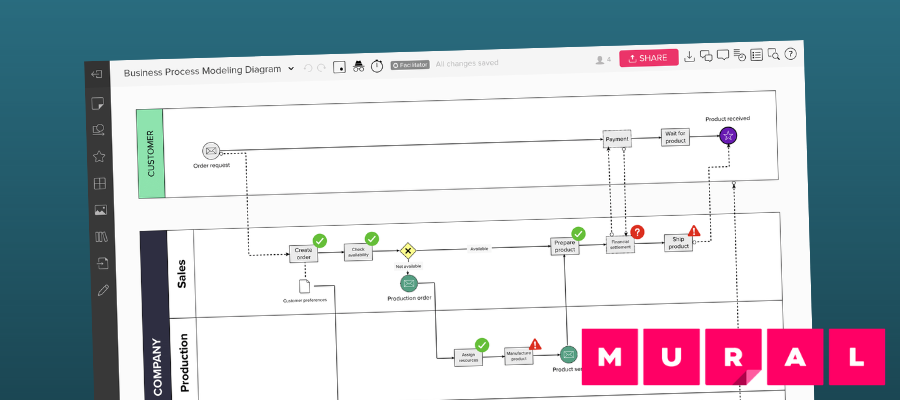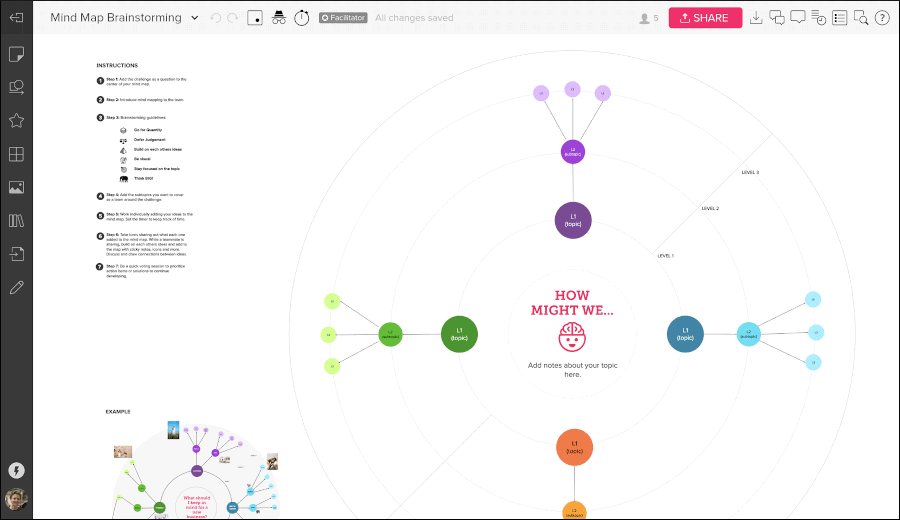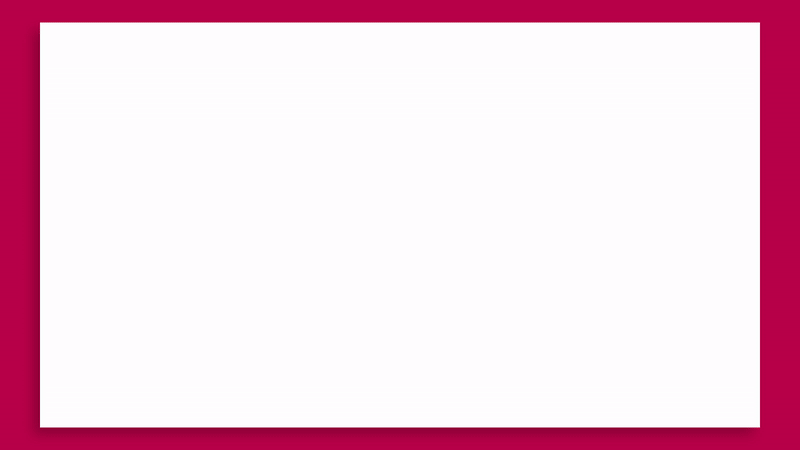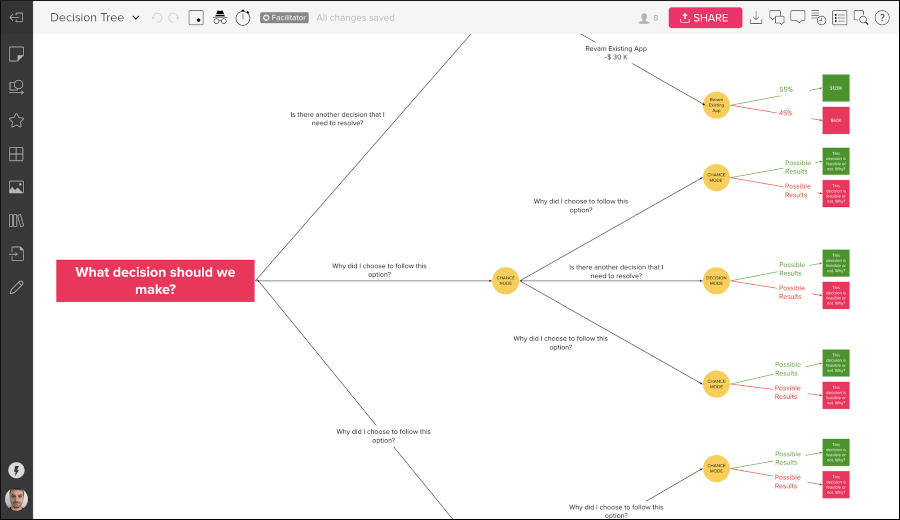
The lines between different types of visual thinking tools continue to blur, driven by the evolving needs of business users. The latest example of this phenomenon is visual collaboration pioneer Mural, which recently added collaborative mind mapping and diagramming tools to its popular platform.
I interviewed senior product marketing manager Thomas Shields to learn more about the thinking behind this major move and how these expanded capabilities are helping remote teams collaborate in today’s radically altered work environment.
 Chuck Frey: First of all, what made Mural decide to add collaborative diagramming and mind mapping to your platform?
Chuck Frey: First of all, what made Mural decide to add collaborative diagramming and mind mapping to your platform?
Thomas Shields: It’s been one of our most requested features. And it’s something we’d been thinking about doing for quite a while. We honed in on three specific ways that people are doing diagramming and mind mapping where we could really help them. We wanted to make sure we could really add value.
The first use case is when people gather in a room to kick off a project or develop an idea. They start mind mapping on a whiteboard or they start mapping out a process. When they’re done, they’ve got a genius idea. What do they do next? Do they take a picture and never do anything with it? Do they transcribe it into a document? That whole process is inefficient and time-consuming.

The second use case is to help people who were building process flows in PowerPoint. It’s not easy to do. Yet we see people doing it all the time in large enterprises, even in organizations that have a reputation for being very innovative. It’s just the way a lot of people have been doing diagramming.
The third use case is companies that provide access to really sophisticated point solutions for diagramming and mapping. We’ve talked to many consultants who tell us they don’t need or use 80% of the features that are available in those tools. Plus, whether you’re talking about dedicated diagramming or mind mapping tools, PowerPoint or whiteboards, most of those tools aren’t collaborative, or they force you to work within a constrained document or workspace.
So we thought we had a unique opportunity to apply Mural’s strengths to help people diagram and mind map more efficiently.
Frey: One of the things I noticed about Mural’s new diagramming and mind mapping tools is that they enable users to work quickly to capture their ideas, with a minimum of friction. Can you tell us about that?
Shields: One piece of feedback we heard prior to building these tools was, “I want to have a tool that can keep up with my thinking.” You could create these types of visuals in Mural before, but it wasn’t easy or fast. So that was our vision, to help users capture ideas at the speed of thought.
Ideally, we want the tool to fade into the background, so it’s not getting in the way of thinking but enabling it. We want to help them quickly transform something that might be a jumble of ideas in their head into something they can easily communicate with colleagues.
Frey: I noticed in one of your videos for the new diagramming and mind mapping functionality that users can filter their diagram objects by type. Where is that useful?
Shields: It’s designed to help users make changes to their maps and diagrams faster and easier. For example, you can select all the connector lines and quickly change all of them to dotted lines or change them to a different color. Or you can select one section of your map and change all of those sticky notes into squares. The main focus of that is enabling people to tweak and adapt their diagrams faster.

Frey: How do the collaborative features of Mural enhance diagramming and mind mapping?
Shields: We see a lot of value in enabling asynchronous work. In other words, people who need to work on diagrams together but not simultaneously. Often, one person creates the first draft of a diagram, but then he needs to send it to other people for review and input. Being able to work in this way is really important, especially today when everyone’s working remotely. Even after people start to return to offices, it’s still going to be a distributed work environment.
Mural is the perfect example of this. We’ve grown quickly to over 500 people on three continents. We like looking at our own processes and exploring how we can improve them. In one recent example, we took eight people from five departments and mapped out a process flow diagram of a launch process in only 30 minutes. Even the meeting participants were surprised at how quickly it came together. At the beginning of the call, one person warned, “I really don’t think we’ll be able to get this done in 30 minutes. We’re probably gonna need another hour after this.” But we made a huge amount of progress in a short amount of time, using Mural.
Another situation where the collaborative mapping and diagramming features of Mural really shine is with consultants. They use our product a lot. They’re often looking to understand processes in their client’s organization. They can meet with a client and talk through each process and quickly capture them in Mural. Because you can invite unregistered users to view your Mural maps, a consultant can provide a link to the client so they can easily access it and review it.
The final use case for collaboration is when you’re developing an idea for a new product or service. It starts out with a mind map and a couple of people. And then it expands out to another team that needs to carry it to the next step. For example, we brainstormed an idea. And now we want to bring in a product manager or a UX designer. We want to start prototyping this idea so that we can get feedback on it. All of that can live in one place. In other words, the collaboration doesn’t just encompass a single diagram but the whole project. We think that’s a better way to approach it.

Frey: One of the interesting dynamics I’ve seen from mind mapping is using it for collaborative brainstorming. Displaying the mind map at the front of the room where everyone can see all the ideas and how their ideas fit into the larger context tends to create an energy that powers more and better ideas. Is that something you see that happening with Mural users?
Shields: Oh, absolutely. It’s super important. Think for a moment about the dynamics of remote collaboration. If you’re on a Zoom call, for example, conversations are one way. Only one person can be speaking at a time. That tends to slow down the flow of ideas. That’s even true to some degree in an in-person meeting, too.
By having everyone work on a collaborative mind map at the same time, you’re able to generate a lot more ideas. You’re able to add your ideas to the map and contribute to the conversation without taking up airtime. That radically increases the volume and quality of ideas the group can generate.
Frey: Now, I’d like to step back a bit and talk about what’s changing in the nature of work, especially with the pandemic and the sudden move to remote work. How is it transforming from your standpoint? Specifically, how is it altering your customers’ needs in terms of visual thinking? Is it playing a bigger role than it did before?
Shields: There’s really no question that it is. The growth of Mural is certainly evidence of that. The reason for it is really very simple: When we all worked in offices, we relied on tools like physical whiteboards to communicate ideas. When those tools were removed, it became a lot harder to communicate ideas and get aligned with each other. That slowed down everything. It made us less productive. And we got fewer good ideas.
Here’s something related that a lot of people don’t think about: Prior to the pandemic, some behaviors were happening during in-person meetings that were counterproductive. But they were such a deeply embedded part of the way meetings were managed that we never gave them much thought. But when we started to work remotely, it really exacerbated those weaknesses and made them more obvious.
For example, during a meeting, only one person can speak at a time. Often, that’s the person who’s in charge. Because of that, you’ve got employees spending time in meetings where they’re not contributing. It’s a big waste of their time and productivity. Also, as we discussed, you’re not getting as many ideas. You hire smart, talented people and pay them a lot of money. But then they don’t contribute their ideas. That’s a big miss.
This is something that was happening for many years in the real world. But once we went remote, it became more painful and obvious. Many businesses are starting to see that a tool like Mural can help them get better ideas, make decisions faster, increase employee productivity and drive more innovation.
Frey: I’m quite familiar with this meeting dynamic, where a small team is brainstorming together and the person with the highest title in the room has a dominant personality. As a result, the introverts clam up. They may fear looking foolish or saying something that may upset the big boss. But in a virtual environment like this, it frees them up. Often, the quiet people have the best ideas. If they’re able to share them anonymously, it tends to level the playing field between everybody and it can make a huge difference.
Shields: Absolutely. An introvert, sitting there quietly, has probably thought about the problem or challenge at a very deep level. Much more so than an extrovert who just spouted off five potential solutions. We recently released a new feature called private mode for this exact purpose. You can make contributions to a board fully anonymously, or you can show the authors after the session ends.
We didn’t know how this feature would be received by our customers. But they love it. They recognize that this is a big issue and it’s an impediment to innovation and growth.
Frey: Do you sense that there’s been an evolution in the complexity of challenges that companies are dealing with in business today? I sense that many of the easy problems have been solved. As a result, we tend to be dealing with systemic issues and more complex challenges that aren’t easily solved. And it seems to me that visual thinking tools like Mural enable you to attack them and dissect them and figure out what to do about them.
Shields: Yes, the world is definitely more complex than it was. The number of places you can get information has grown exponentially. The volume of data that companies can consider to make decisions is radically larger. Where visual thinking can help is that it can give you a perspective that helps you to simplify and make sense of your world.
I like to think of it in terms of “black boxes.” With any business process, there are inputs and outputs. But between them, there’s a black box that we can’t see into. Being a good manager is all about understanding what’s in that black box. Mural can help you make sense of information and data and ideas. Obviously, it’s the only tool that enables you to do that but having a visual layer to view it is really helpful.
We understand information differently when we visualize it. When we think visually, we can also communicate ideas differently.
The second part of this issue is that the ability of the average person to think or communicate ideas has always been constrained by the tools they use. For example, word processing documents are very linear. Slide decks are a little less linear, but the format still constrains how you can arrange and present ideas. At Mural, we believe in constraints. But they need to be applied in certain ways to enhance thinking, not restrict it.
The shape of a document matters. We believe that the combination of visual thinking and a flexible document shape changes the way people think and the way they understand our complex world.
Frey: Indeed. If you think about it in the broadest sense, even a whiteboard or a flip chart has constraints. There’s only so much room on a page or the board.
Shields: Yes. That’s exactly right.
Frey: One consultant once told me that he uses visual thinking tools to map out the formal and informal governance structures of large organizations. He said that there are several things make this difficult for enterprises: First, because of multiple rounds of downsizings and reorganizations, many people are gone – either retired or outplaced. Their knowledge left with them, of course. Also, as a company gets larger, people tend to get put into narrow and narrower roles. As a result, no one has a total picture of how the organization really works in terms of governance. He brings a multi-functional team of executives into a room, facilitates a discussion of these formal and informal relationships, maps them out and validates them with the group. At the end of the session, everybody has a shared picture of it for the first time.
Shields: That’s really interesting. Two things jump out at me. First, in large organizations, there’s so much informal connection and there are so many informal relationships and serendipitous moments where people informally interact and share ideas about disparate projects. Visualizing those is really important. It helps us to see something we couldn’t see before – how our teams and departments and business units are collaborating.
Here at Mural, we’ve been accumulating a really interesting dataset that we call the collaboration graph. If you recall, Facebook has a social graph, which visualizes how people are connected in its social groups. Well, what’s the graph that reveals how people are collaborating in large organizations? Without a tool like Mural, you could never visualize or understand that. We believe we can use this dataset to provide Fortune 100 companies with insights into how their people are working together. That’s never been done before. I think the collaboration graph could be a really powerful tool.
Frey: What’s the outlook for visual collaboration tools for the next few years?
Shields: I think it’s going to be strong. As we’ve discussed, there were a large number of organizations that, prior to the pandemic, didn’t use visual thinking tools other than a whiteboard. They now have these digital tools for visual thinking, which are providing them with a ton of value.
Visual collaboration was growing prior to the pandemic. It simply accelerated the adoption of it. As businesses return to pre-pandemic work practices, I predict most of them won’t return to their old ways of collaborating. The benefits of using visual collaboration tools like Mural are too great to treat them as a temporary fix. I think these tools will become a permanent part of how they work and collaborate.
Frey: Based on what you’re describing, it sounds like Mural grows by first establishing a beachhead within a company. One team or department starts using it and seeing benefits from it. Word spreads. Soon, the company buys more seats because they want to share this new way of working and collaborating to other corners of the company. Does that sound like an accurate scenario?
Shields: Yes, definitely. In our product, sharing is a core part of what you do. It’s not something we added to make Mural more viral. It’s baked into the core way you use the product and its value proposition. So, I think you’ll continue to see that.
Frey: One of the potential growth areas I see is using visual collaboration tools with people outside of your organization, such as your suppliers, distributors and other organizations up and down your value chain. It can help you work together with them to solve problems and uncover new efficiencies and opportunities.
Shields: Absolutely. As we discussed earlier, many consultants – from small, independent practitioners to the world’s largest management consulting firms – use Mural because it’s a great way for them to work closely with their clients. Many of them historically used PowerPoint to deliver their findings. Instead, Mural enables them to work together with their clients in a collaborative environment. It’s a game-changer for them.
This type of value-chain collaboration is something we’re starting to see and it’s growing. If you look at what’s happening with other collaboration platforms, they’re starting to support it, too. A great example is Slack Connect, which they rolled out just for that purpose. I think that’s where a lot of collaboration tools are heading and it’s something we’re uniquely positioned for. We’ve always had customers who want to work with people outside of the walls of their company. Our toolset is designed to support it.
Frey: In closing, is there anything else that my readers should know about what’s next for Mural? For example, I noticed on your blog that you launched a group of templates when you announced the new diagramming and mind mapping capabilities, but it sounds like there’s more coming. Is that right?
Shields: Yes. We launched it with 15 templates. Our plan is to continue to build and release new templates every quarter. We also take requests from our customers, turning their best practices into templates, too.
In addition to templates, we plan to implement labels on connector lines. Also on the near-term roadmap are more shapes and additional keyboard shortcuts. You’ll be able to create a mind map using only your keyboard. Overall, we want to help users of Mural to collaborate at the speed of thought.
A big theme for us this year is connecting your work with other platforms. So, for example, if you’re brainstorming and planning in Mural, you can easily connect the work you’ve done on our platform to your project management tool. At the end of April, we’ll be releasing three new integrations with different Atlassian tools to support that vision. Atlassian, as you know, is very much centered around product teams and agile teams.
Finally, you can expect to see a continued emphasis from Mural on supporting facilitation. We’ll continue to innovate and add new tools to help people who need to lead or facilitate meetings effectively. We’ve already invested a lot in it and we’ll continue to do so.

Leave a Reply